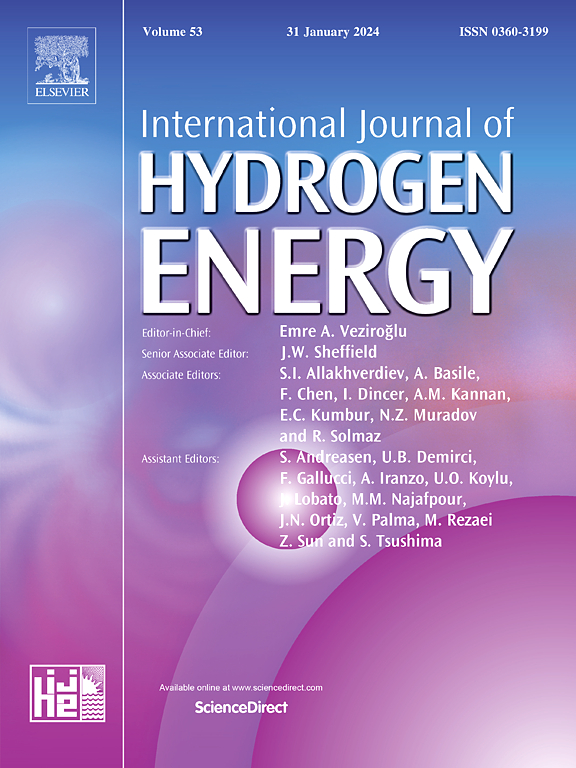Experimental and simulation study on the sealing performance of rubber O-rings exposed to hydrogen conditions
IF 8.1
2区 工程技术
Q1 CHEMISTRY, PHYSICAL
引用次数: 0
Abstract
As the key link of pure hydrogen and hydrogen-doped pipeline system, rubber O-ring sealing element is of great significance for the safe and efficient transportation of pipeline. The variation law of leakage rate of rubber O-ring under various factors such as preload, sealing ring size, hydrogen pressure and hydrogen blending ratio was explored from a macro perspective through experiments, and the mechanical properties of rubber materials under hydrogen permeation conditions were further studied from a micro perspective through simulation. The results show that: (1): Under the condition of hydrogen permeation, with the increase of preload torque, the leakage rate of the sealing system shows a trend of decreasing first and then increasing. When the diameter of the O-ring is constant, the leakage rate tends to increase linearly with the increase of the inner diameter, and the sealing performance is weak. With the increase of hydrogen pressure, the gas leakage rate decreases exponentially. The hydrogen blending ratio is negatively correlated with the leakage rate, and increasing the hydrogen blending ratio will promote the sealing performance. (2) Under the condition of hydrogen permeation, the contact stress of the rubber O-ring increases linearly with the increase of hydrogen pressure. Substituting it into the leakage rate formula, it is found that the leakage rate decreases, which is consistent with the experimental conclusion, but the pressure rise will also increase the Mises stress, and cause the volume of the O-ring outside the extrusion groove to increase, accelerating the sealing failure. The increase of hydrogen blending ratio will increase the contact stress and reduce the Mises stress, but the effect is not obvious. (3) A theoretical formula of hydrogen leakage rate with multiple independent variables and single dependent variable is established. Suggestions on the selection of flange seals and the application of process operation parameters in hydrogen environment are put forward, which provides theoretical support for the safe transportation of pure hydrogen or hydrogen-doped natural gas pipelines.
氢化条件下o型橡胶密封圈密封性能的实验与仿真研究
橡胶o型圈密封元件作为纯氢和掺氢管道系统的关键环节,对管道的安全高效输送具有重要意义。通过实验从宏观角度探索预紧力、密封圈尺寸、氢气压力、氢气掺混比等因素对橡胶o型圈泄漏率的影响规律,通过仿真从微观角度进一步研究橡胶材料在氢气渗透条件下的力学性能。结果表明:(1)在渗氢工况下,随着预紧扭矩的增大,密封系统的泄漏率呈现先减小后增大的趋势;当o型圈外径一定时,泄漏率随内径的增大呈线性增加的趋势,密封性能较弱。随着氢气压力的增加,气体泄漏率呈指数下降。氢气掺混比与泄漏率呈负相关,增加氢气掺混比有利于提高密封性能。(2)在氢气渗透条件下,橡胶o型圈的接触应力随氢气压力的增大而线性增大。代入泄漏率公式,发现泄漏率减小,与实验结论一致,但压力升高也会使米塞斯应力增大,导致挤出槽外o形圈体积增大,加速密封失效。掺氢比的增加会增加接触应力,降低米塞斯应力,但效果不明显。(3)建立了多自变量、单因变量的漏氢率理论公式。对法兰密封的选择和氢气环境下工艺操作参数的应用提出了建议,为纯氢或掺氢天然气管道的安全输送提供了理论支持。
本文章由计算机程序翻译,如有差异,请以英文原文为准。
求助全文
约1分钟内获得全文
求助全文
来源期刊

International Journal of Hydrogen Energy
工程技术-环境科学
CiteScore
13.50
自引率
25.00%
发文量
3502
审稿时长
60 days
期刊介绍:
The objective of the International Journal of Hydrogen Energy is to facilitate the exchange of new ideas, technological advancements, and research findings in the field of Hydrogen Energy among scientists and engineers worldwide. This journal showcases original research, both analytical and experimental, covering various aspects of Hydrogen Energy. These include production, storage, transmission, utilization, enabling technologies, environmental impact, economic considerations, and global perspectives on hydrogen and its carriers such as NH3, CH4, alcohols, etc.
The utilization aspect encompasses various methods such as thermochemical (combustion), photochemical, electrochemical (fuel cells), and nuclear conversion of hydrogen, hydrogen isotopes, and hydrogen carriers into thermal, mechanical, and electrical energies. The applications of these energies can be found in transportation (including aerospace), industrial, commercial, and residential sectors.
 求助内容:
求助内容: 应助结果提醒方式:
应助结果提醒方式:


